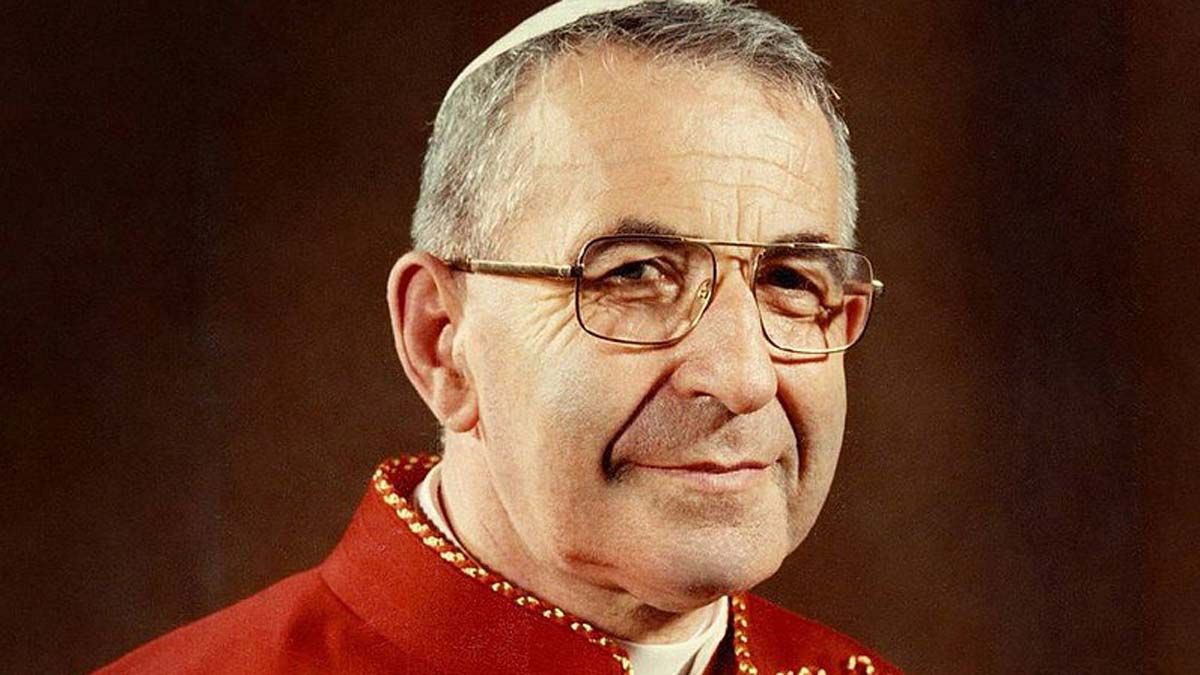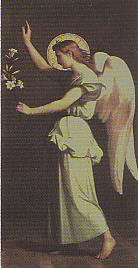From Forums of the Virgin Mary [translated; views expressed are those of website]:
The death of John Paul I is perhaps the greatest mystery that has engulfed the Church in the 20th century.
Few are those who believe in the politically-correct version that he died peacefully in his bed of a heart attack.
And the suspicions come from the unusual things that the Vatican authorities did right away: no autopsy, and immediate embalming.
We already talked about the widely circulated theory that Pope Luciani died of poisoning when he was going to investigate a financial fraud carried out through the Vatican Bank, by the Propaganda 2 Lodge and the Mafia.
But there are other theories.
Here we will talk about other great theories, that he died when the appointment of progressive bishops within the Church was going to be brought to a halt, stymying a network of Freemasons, who had reached high positions in the Vatican.
We will tell how this network of infiltrated Freemasons was managed, how John Paul I had discovered it, and how it is related to his death.

When John Paul I is beatified on September 4, 2022, he will be the final of all deceased post-Vatican Council Popes elevated to the altar. A circle will have been closed.
The miracle attributed to John Paul I, which made his beatification possible, is the healing of an Argentine girl, Candela Giarda, who, at the age of 11, in July 2011, was diagnosed with a malignant disease, with no expectation of life, to the point that doctors said she would not last that night.
The priest of the parish to which the hospital belonged suggested praying to John Paul I, to whom he was devoted, for the girl’s cure.
The recovery began the next day, and it was long, lasting three years, but in the end it worked.
Albino Luciani was 65 years old when he was elected Pope on August 26, 1978; taking the name of John Paul I, he was the first Pope born in the 20th century.
He was in generally good health at the time, although he had had heart problems a few years earlier and was taking heart medication.
And he died 33 days later, becoming the Pope that the reputed Virgin in Garabandal did not count, due to his short pontificate, in the prophecy of the Popes.
His death was considered strange, both inside and outside the Vatican, because of the way it was handled. [scroll for more]
The Vatican said that John Paul I died of “myocardial infarction,” but because an autopsy was never performed, how can they be sure?
According to the official account, the Pope was found sitting up in bed, still holding his reading material and sporting his characteristic smile.
And it has been questioned whether that peaceful and serene pose matches the description of a person who has just suffered a massive heart attack.
John Paul I’s body was embalmed immediately after it was discovered, in a departure from both Vatican protocol and Italian law, raising suspicions that officials were trying to hide possible evidence of blood poisoning, for example .
However, there are scientists who say that early embalming probably would not have been enough to prevent the detection of poison in the blood.
So an autopsy can still be performed, since the body must be in good condition, although the probability of it being done is rather slim.
There is a strong tendency to think that the death of John Paul I was provoked in some way.
And there are several theories about it.
Some authors have pointed fingers at the CIA, speculating that the U.S. government was eager to have a Pope more aligned with U.S. foreign policy interests.
Traditionalist groups have floated the theory that John Paul I was preparing to restore the Traditional Latin Mass as the norm for the Catholic Church, and that this was not acceptable to modernists.
But the most widespread theories point to the Mafia in conjunction with Freemasonry, or ecclesiastical Freemasonry.
On the theory that the mafia and civil Freemasonry were responsible, we have made a video https://youtu.be/Z8FunQQL0rQ .
The theory is that several high-level Church officials were involved in financial fraud with the Vatican Bank.
And John Paul I was about to order an investigation, which could have exposed the scandal, involving the Propaganda Lodge and Italian-American mobsters. [scroll for more]
The two central figures in this theory are Archbishop Paul Marcinkus, who was considered more of a gangster than a man of the Church, and the then Vatican Secretary of State, Jean Villot. [Views expressed are not necessarily ours and must be taken into discernment.]
And then there is the theory that ecclesiastical Freemasonry itself was responsible for the death of Pope Luciani, in a struggle to change the doctrine of the Church, as Father Charles Murr has said in a book entitled 33rd Degree Murder.
The theme derives from the fact that Paul VI had asked Archbishop Edouard Gagnon to investigate whether or how Freemasonry may have infiltrated in the Church.
Father Charles Murr was Gagnon’s secretary, therefore the information in the book is first-hand.
Archbishop Gagnon complied with Paul VI’s request to provide an in-depth report on how the “smoke of Satan” had entered the Church.
And he pointed out two central figures of ecclesiastical Freemasonry; one was Annibale Bugnini, the architect of the Mass of the Novus Ordo.
In 1978, Paul VI removed Bugnini from that post and sent him to Iran as apostolic nuncio, where, according to Murr, he was thought to do less harm.
But Gagnon was dismayed when the elderly and ailing Pope Montini made it clear that he would pass Gagnon’s investigation of the other great figure of ecclesiastical Freemasonry, Cardinal Sebastiano Baggio, Prefect of the Congregation for Bishops, the dicastery that handles the selection of new bishops, to the next Pope for completed inquiry.
In his twelve years at the helm of bishop appointments, Baggio imposed a retirement age of 75 on the episcopate, allowing him to appoint liberal-leaning bishops around the world more quickly.
Father Murr maintains that it was Baggio who appointed the large number of progressive prelates, who made possible the doctrinal destruction that has been seen in recent decades in the Church.
Baggio, argues Charles Murr, was not simply a progressive or modernist but a Freemason who exclusively elected liberal bishops, and any orthodox bishop or archbishop who managed to be appointed during those years happened only due to the dramatic efforts of the orthodox members of the Roman Curia to convince the Pope, which infuriated Baggio.
According to Murr, Baggio and Bugnini’s membership in Freemasonry was confirmed by documentation verified as authentic by Interpol special agents.
At the start of the new pontificate, Archbishop Gagnon met with John Paul I on September 25, 1978, and they discussed Baggio’s removal.
And three days later, on September 28, 1978, the same day of his death, John Paul I summoned Baggio to his office at night.
The time of day and the absence of others at the meeting were unusual.
Baggio entered the papal apartments after 8 p.m. and was the last person to speak to the Pope.
Following the advice of Cardinal Benelli, Pope John Paul I was going to tell Baggio that he was dismissing him from the Congregation for Bishops.
No one but the Pope and Baggio can testify to what happened, as two Swiss Guards stood guard outside the door.
The meeting lasted about an hour.
The only testimony about that papal meeting came a few days later from one of the Swiss guards on duty, who said he could hear Baggio’s angry voice yelling through the door, suggesting a heated confrontation with the Pontiff.
And that Baggio left furious after that hour.
Father Murr speculates that the confrontation between the Pope and the high-ranking Cardinal, a member of both the Roman Curia and the Masonic Lodge, may very well have been what gave the Pope a heart attack just hours later.
John Paul I was found dead the next morning at 4:45 am.
Pope Luciani was unable to document Cardinal Baggio’s removal from office due to his death, so John Paul II inherited it and soon after put the former appointer of bishops in charge of printing and distributing Vatican City postage stamps, in clear demotion; though the damage was already done.
According to Father Murr, Baggio lived until 1993 with Pope John Paul II watching his every move.
Meanwhile, Murr had asked the Vatican to publish the report of Gagnon’s investigation into the presence of Freemasons within the Roman Curia, including the documentation on Bugnini and Baggio.
Well, so far we wanted to talk about the other most widespread theory about the provoked death of John Paul I, we already made a video about the first one that I recommend you watch.
And I would like to ask you if you think that the current doctrinal crisis in the Church is due to the Masonic infiltrators’ strategy of appointing progressive and modernist bishops. relegating the most orthodox to traditional doctrine or not.
[Return to www.spiritdaily.com]


